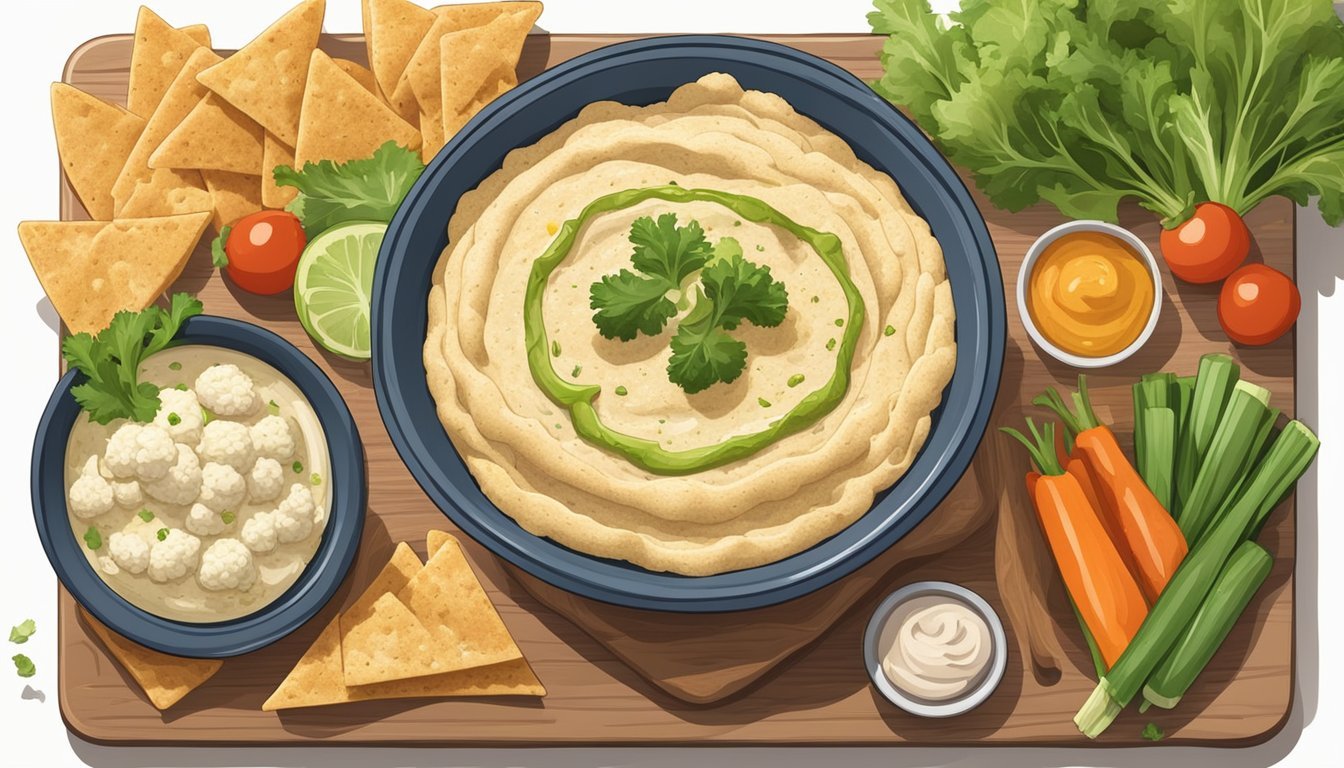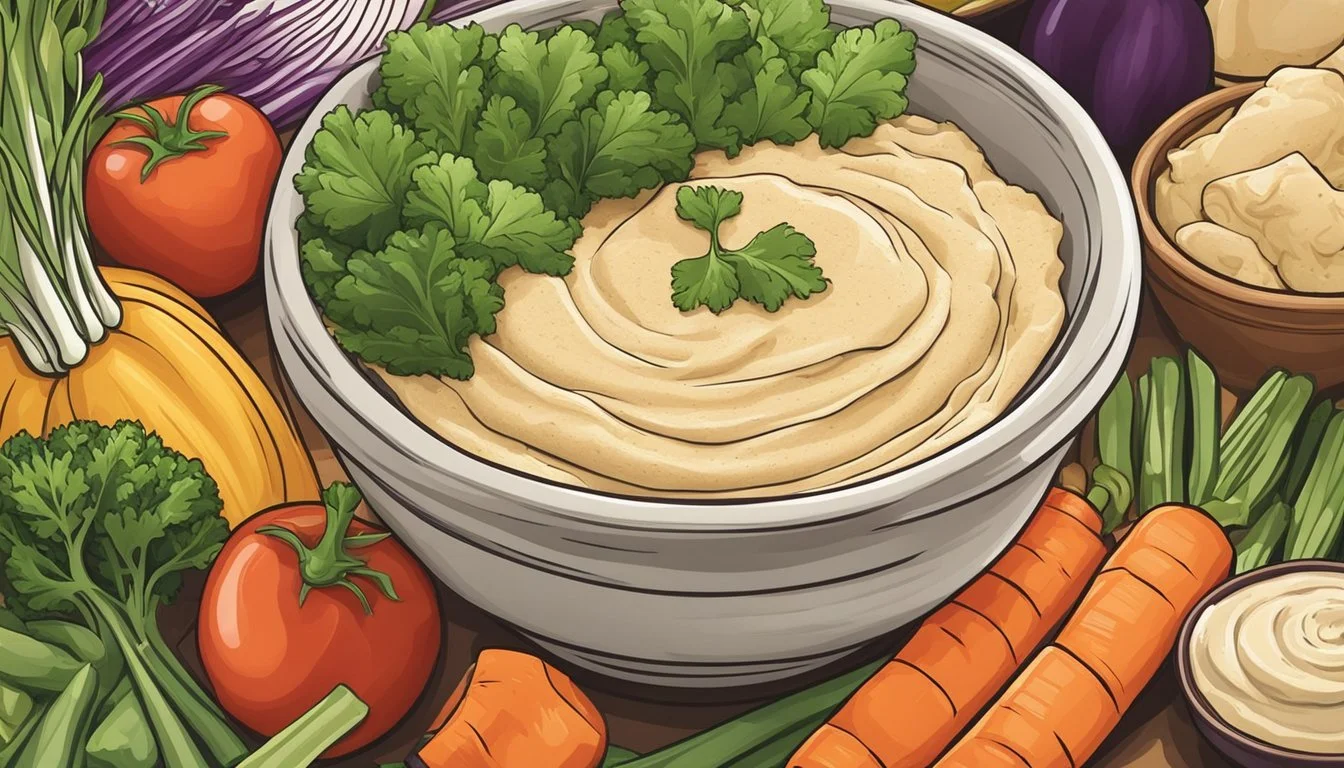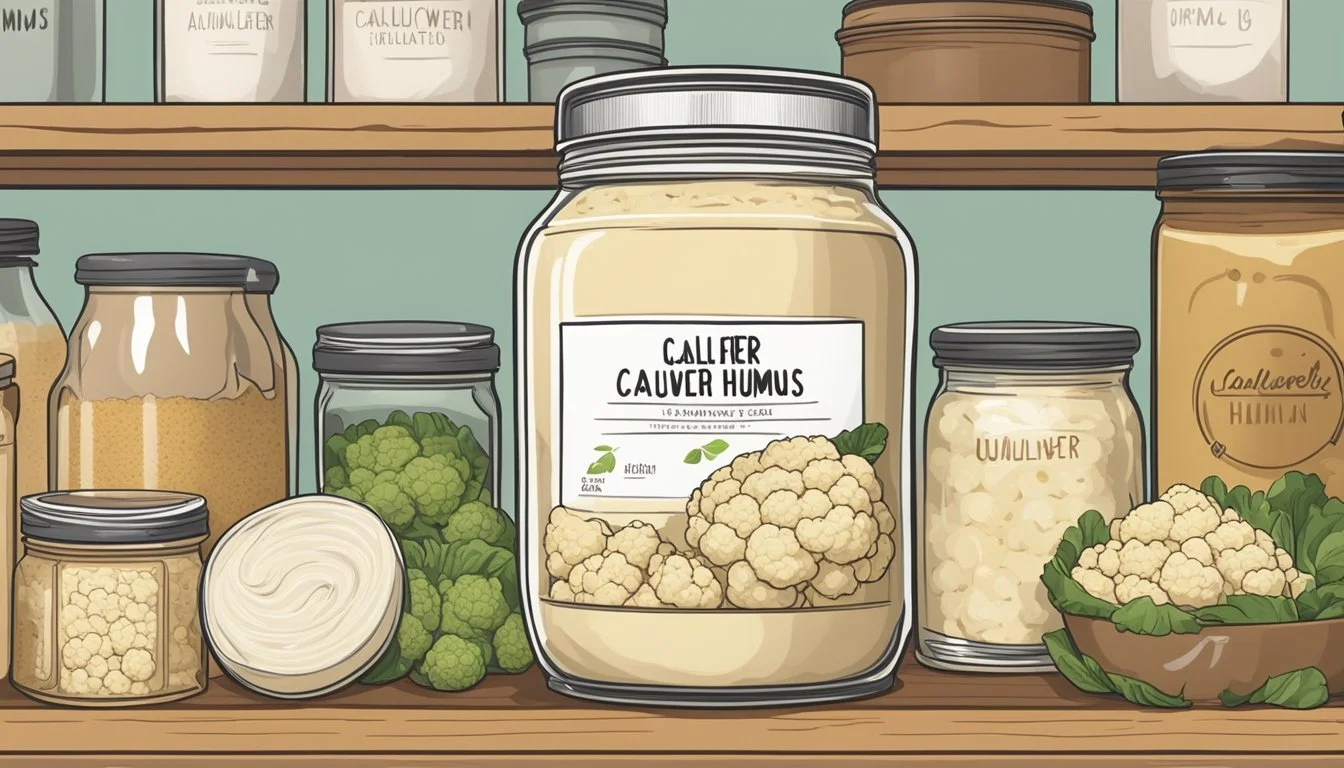Cauliflower Core Hummus
The Ultimate Creamy, Low-Carb Dip Delight
Cauliflower hummus introduces a fresh spin on the classic dip, marrying the creamy texture and richness of traditional hummus with the nutritious benefits of cauliflower. Unlike its chickpea-based counterpart, cauliflower hummus is both low in carbohydrates and versatile, making it an ideal food choice for those following ketogenic and paleo diets, or anyone looking to enjoy a lighter version of the beloved spread. The foundation of the dish is roasted cauliflower, puréed to a silky smooth consistency and combined with tahini, lemon juice, olive oil, and seasonings, which results in a flavorful and healthful alternative to traditional hummus.
The preparation of cauliflower hummus is straightforward, with the core steps mirroring that of its more established relative. It begins with roasting the cauliflower to a soft texture and a slightly browned exterior, which brings out the vegetable's natural sweetness and depth of flavor — an essential step to ensure the final product's desirable taste and texture. After cooling, the cauliflower is then blended with typical hummus ingredients, producing a dip that is not only creamy and satisfying but also accommodating to a spectrum of dietary preferences.
This culinary innovation doesn't sacrifice taste for health benefits; instead, it offers a harmonious blend of both. Rich in vitamins and fiber, cauliflower is a nutritious alternative base that results in a hummus with a more subtle taste, yielding a canvas that graciously complements an array of seasonings and garnishes. Whether served with an array of crisp vegetables, warm pita, or as a novel spread on sandwiches, cauliflower hummus stands as a testament to the versatility and continual evolution of traditional dips.
Nutritional Profile
Cauliflower core hummus is celebrated for its low-carb quality, aligning well with keto and paleo dietary frameworks. By incorporating cauliflower as a primary ingredient, this hummus variant achieves a lower net carb content, which is beneficial for those tracking their carbohydrate intake on a low-carb diet.
The hummus contains proteins and fats that can contribute to satiety, supporting a balanced diet. The calories in cauliflower core hummus are typically less than those found in traditional hummus, where chickpeas are the main ingredient.
Cauliflower core hummus is also versatile, being inherently gluten-free, grain-free, dairy-free, and lectin-free, making it suitable for those who follow vegan and vegetarian lifestyles. Its nutritious profile is enriched by the use of tahini, a sesame seed paste, which has its own set of health benefits, including healthy fats.
Nutrient Benefit Low Net Carbs Ideal for keto and low-carb diet adherence Proteins Contributes to muscle health and satiety Healthy Fats Provides sustained energy, supports cell health Vitamins & Minerals Derived from cauliflower and garlic; essential for body functions
By opting for healthful oil choices, such as olive or avocado oil, creators of this dip enhance the flavor profile while maintaining the hummus's status as a nutritious, keto-friendly, and low-carb choice. This diversity in its preparation caters to a broad range of dietary preferences and restrictions, fortifying its position in the health food domain.
Essential Ingredients
Crafting a creamy, low-carb Cauliflower Hummus requires several key ingredients. Incorporating these with precision will enhance the flavor profile and ensure a consistent texture for this delectable spread. Below are the essentials categorized for clarity.
Cauliflower as the Base
Steamed or Roasted Cauliflower Florets: A medium-sized head, approximately 1 pound, steamed until tender or roasted to enhance the flavor.
Cauliflower Rice: An alternative to florets, cauliflower rice can also be used for a finer texture.
Taste Enhancers
Tahini: 1/4 cup, creating a rich and nutty flavor base.
Fresh Garlic: 1-3 cloves, roasted or raw depending on your taste preference.
Lemon Juice: From one large lemon for freshness.
Extra Virgin Olive Oil: 2-3 tablespoons for smoothness.
Optional Additions
Chickpeas or Edamame: Up to 1/2 cup if you're looking for a slight protein boost.
Roasted Red Peppers or Sun-Dried Tomatoes: A few tablespoons to add a sweet and tangy flavor.
Garnishes and Toppings
Parsley: Chopped, for a fresh garnish.
Sesame Seeds or Chives: A sprinkle for extra taste and presentation.
Olive Oil: A drizzle of high-quality olive oil just before serving adds a touch of richness.
Spices: A pinch of sumac, paprika, or smoked paprika for color and spice.
Preparation Techniques
Creating a batch of Cauliflower Core Hummus requires a mindful approach to preparation, ensuring the dip maintains a creamy texture and bursts with flavor. Here are a few pivotal techniques one will need to master.
Processing the Hummus
To achieve the ideal consistency for hummus, one should use a food processor or a blender. These appliances effectively combine the ingredients into a smooth, creamy dip. For the best results, start by blending the tahini and lemon juice, then add the roasted or steamed cauliflower and seasonings.
Cauliflower Cooking Methods
The cooking method for the cauliflower greatly affects the flavor and texture of the hummus:
Roasted Cauliflower: Toss florets with olive oil and roast in an oven preheated to 400 degrees F for 35-45 minutes until brown and tender. Roasting enhances the dip’s richness.
Steamed Cauliflower: Combine cauliflower with a small amount of water and steam until softened. Steaming creates a milder taste and is quicker than roasting.
Once cooked, some prefer to chill the cauliflower in cold water to stop the cooking process and ensure a cool hummus.
Texture and Consistency Tips
One's attention to texture is crucial:
For a creamy hummus, ensure the cauliflower is cooked until very tender.
If the hummus is too thick, add cold water, a tablespoon at a time, while processing until the desired consistency is reached.
Flavor Adjustment
The secret to a memorable hummus lies in its balance of flavors. Begin with the basic ingredients:
Tahini: Provides richness.
Lemon juice: Adds freshness, and consider using lemon zest for an extra citrus note.
Seasonings: Salt, garlic, and other spices should be adjusted according to one's taste.
The seasoning can be altered and taste-tested during the processing stage, making this an easy-to-make dip suitable for meal prep.
By adhering to these techniques, one can prepare a cauliflower hummus that is not only low in carbohydrates but also versatile as a dip or spread.
Serving and Pairing Suggestions
Cauliflower core hummus offers a delectable and healthy spin on classic hummus, tailored for those who follow a low-carbohydrate diet or simply seek variety in their culinary experiences. This section will guide you through various ways to enjoy this creamy, low-carb dip.
As an Appetizer or Snack
For a satisfying appetizer or snack, cauliflower core hummus is an excellent choice. It pairs well with an assortment of keto-friendly crackers made from seeds and nuts for a crunch that complements its creamy texture. Vegetables such as carrot sticks, celery sticks, and cucumber slices can be dipped into the hummus for a refreshing and health-conscious option.
Edamame hummus: A variation that can further reduce carbs while adding protein.
Dip recipes: Incorporate cauliflower hummus into your favorite low-carb dip recipes for extra flavor.
Using Hummus in Meals
Cauliflower core hummus can enhance any meal with its rich flavor. It can double up as a spread in sandwiches for a mediterranean touch or served alongside cauliflower mashed potatoes for a comforting, wholesome meal. Incorporating it into a dish like shakshuka can also add a luxurious creaminess.
Mediterranean dishes: Merge the hummus with other Mediterranean components for a truly delectable experience.
Recommended Accompaniments
There is a myriad of options when it comes to pairing cauliflower core hummus with other items. Listed below are some recommended accompaniments:
Type Accompaniments Crispy Bites Pita chips, tortilla chips Fresh Veggies Carrots, celery sticks, cucumber slices Low-Carb Options Keto crackers, vegetable slices Meal Components Cauliflower mashed potatoes, in sandwiches, with shakshuka
Snack variations: Experiment with different kinds of low-carb crackers and veggies to keep snacking interesting.
Hummus recipes: For those who wish to explore beyond cauliflower, recipes using low-carb ingredients like edamame offer delicious alternatives.
Storage and Shelf-Life
Proper storage is paramount for maintaining the freshness and taste of Cauliflower Core Hummus. Adhering to optimal refrigeration, freezing, and preparation practices ensures that this low-carb dip remains a delightful treat.
Refrigeration Best Practices
Cauliflower Hummus should be stored in the refrigerator at or below 40ºF. Consumers should place the hummus in an airtight container immediately after preparation or use. Consistent refrigeration retards spoilage and helps in preserving the hummus for about 5-7 days.
Freezing and Thawing
For long-term preservation, Cauliflower Hummus can be frozen. It's advisable to portion the hummus into smaller, meal-sized containers. These portions should be placed in airtight containers or heavy-duty freezer bags. This snack can be thawed in the refrigerator overnight when ready to consume.
Freshness Tips
To assure the integrity of the hummus, it should be handled with clean utensils during serving. It's best consumed shortly after preparation and should not be left at room temperature for more than two hours. To maintain its creamy texture, avoid repeated temperature fluctuations.
Health Considerations
Cauliflower hummus can be a nutritious addition to various diets, catering to those with specific dietary restrictions or allergies. It is known for its low-carb profile and compatibility with keto-friendly diets.
Dietary Restrictions
Low-Carb Diet: Cauliflower hummus is low in carbohydrates, making it suitable for individuals following a ketogenic diet.
Gluten-Free: As it does not contain any wheat, barley, or rye, cauliflower hummus is an excellent option for those on a gluten-free diet.
Dairy-Free: Typically, cauliflower hummus is dairy-free, appealing to those who are lactose intolerant or dairy-sensitive.
Grain-Free: This hummus variant does not include grains, aligning well with grain-free dietary plans.
Lectin-Free: Cauliflower-based hummus lacks lectins, which are avoided in some health-conscious circles for their potential to impact nutrient absorption.
Chickpea-Free: People who choose or need to avoid chickpeas can enjoy cauliflower hummus as a flavorful alternative.
Allergies and Sensitivities
Allergens: Traditional ingredients in cauliflower hummus, such as tahini, are derived from sesame seeds, which are allergens for some individuals. Recipes can be adjusted to omit or replace these ingredients.
Nutritional Profile: It offers a healthy nutritional profile rich in vitamins, fiber, and is easy to digest.
By choosing cauliflower hummus, consumers can enjoy a creamy, flavorful dip that aligns with a variety of dietary needs and preferences while providing a nutritious, digestible snack option.





